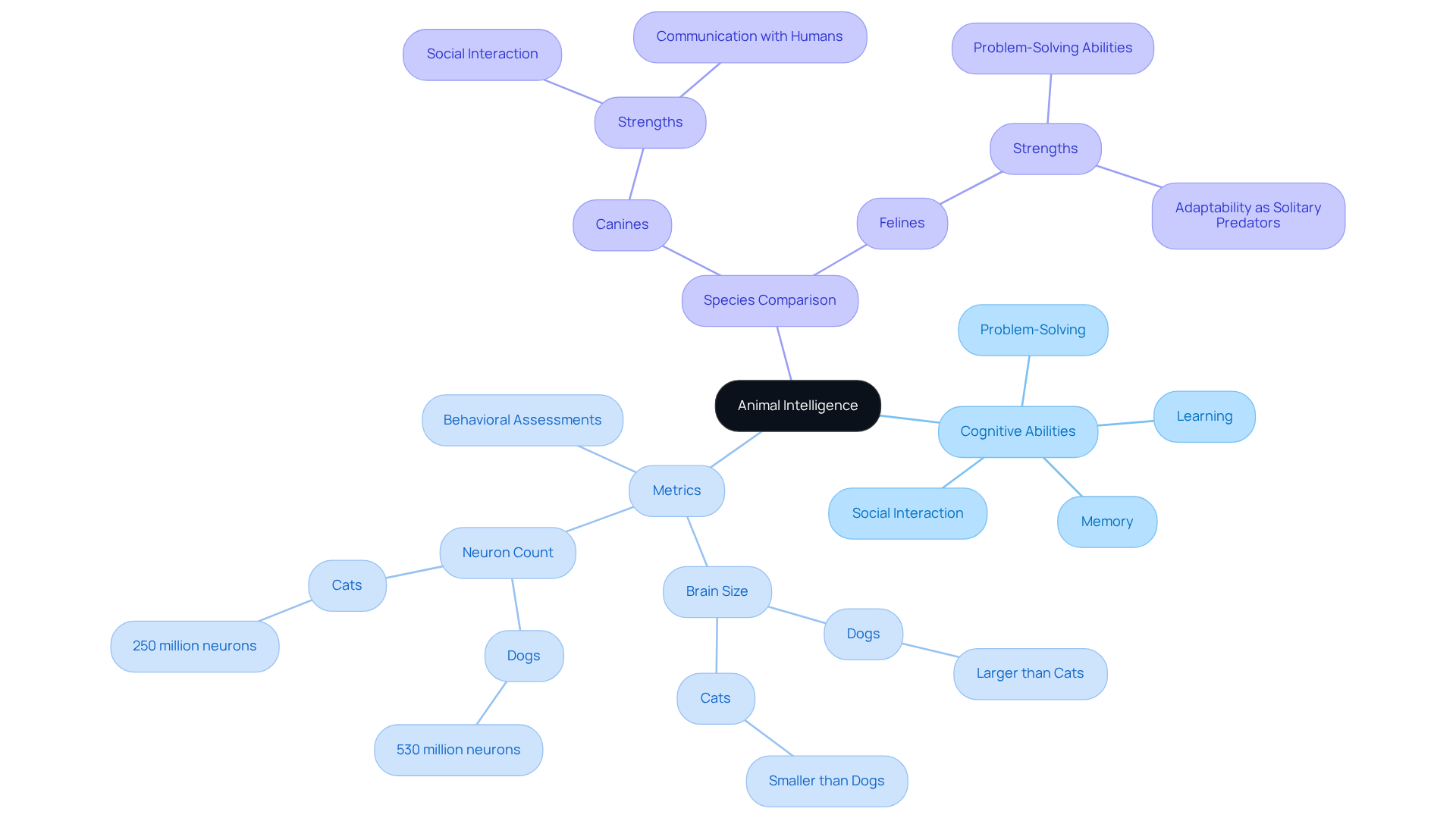Are Cats Smarter Than Dogs? A Comparative Analysis of Intelligence
Overview
The question of whether our beloved cats are smarter than dogs is indeed a complex one, and it doesn’t offer a straightforward answer. Both species showcase unique forms of intelligence that are perfectly suited to their lifestyles, which is something many pet owners can relate to.
While it’s true that dogs have a greater number of neurons, which often translates to strengths in social problem-solving and communication, let’s not overlook the remarkable abilities of cats. They exhibit exceptional problem-solving skills and impressive memory, reflecting their independent and adaptive nature.
Understanding these differences can help us create a nurturing environment for our furry family members, ensuring they thrive in their own unique ways.
Introduction
The ongoing debate about whether cats are smarter than dogs has truly captivated pet owners and animal lovers, sparking heartfelt discussions about the intelligence of our beloved furry family members. This exploration delves into the unique cognitive abilities of both species, highlighting how their distinct evolutionary journeys have shaped their intelligence. As we reflect on this conversation, we invite you to ponder:
- Can we genuinely measure intelligence in a way that honors the unique strengths and skills of both cats and dogs?
- Or do these wonderful animals simply shine in their own remarkable ways?
Understanding Animal Intelligence: Definitions and Metrics
Animal cognition encompasses a range of cognitive abilities, including problem-solving, learning, memory, and social interaction. As pet owners, you may wonder how these abilities manifest in your furry family members. Metrics for evaluating cognitive ability typically include brain size, neuron count, and behavioral assessments. The Encephalization Quotient (EQ) is a widely used measure that compares brain size relative to body size, while neuron counts in the cerebral cortex offer insights into potential cognitive capabilities. Understanding these definitions and metrics is essential for making equitable comparisons between felines and canines, especially when considering if cats are smarter than dogs, as it highlights the varied expressions of intelligence across species.
Recent research reveals that canines possess approximately 530 million neurons in their cerebral cortex, compared to around 250 million in felines. This significant difference indicates that canines may have a neurological edge in certain cognitive tasks, especially those related to social interaction and communication with humans. With nearly 300 million more neurons than felines, canines showcase impressive cognitive capabilities. However, mental capability is multifaceted, and these metrics must be contextualized to fully appreciate the unique strengths of each species. For instance, while canines excel in tasks requiring compliance and interpersonal signals, the question of whether cats are smarter than dogs can be explored through the exceptional problem-solving abilities and adaptability of felines as solitary predators.
As Brian Hare aptly puts it, “Asking which species is smarter is like asking if a hammer is a better tool than a screwdriver.” Therefore, a thorough comprehension of animal cognition necessitates acknowledging the unique abilities inherent to both canines and felines. Additionally, recognizing the individual differences in cat personalities complicates their examination, but it also enriches our understanding of their behaviors. At Adventure Den, we celebrate these differences, ensuring a nurturing environment that caters to the unique needs of all pets.

Evaluating Canine Intelligence: Strengths and Capabilities
Dogs are truly remarkable companions, renowned for their extraordinary relational intelligence that shines through in their ability to understand human gestures, emotions, and commands. This advanced social cognition has developed over thousands of years of domestication, allowing our furry family members to thrive in collaborative roles alongside us, whether it’s herding, hunting, or providing invaluable service. Studies reveal that dogs can comprehend an average of 165 terms, with certain breeds, like Border Collies, mastering over 1,000 words and gestures. This showcases their incredible learning ability, making their cognitive skills relatable to families everywhere, as they often mirror the understanding of a two-year-old child.
In addition to their interpersonal talents, dogs exhibit impressive problem-solving skills that can leave us in awe. Research indicates that they can navigate complex tasks, such as opening doors or solving puzzles to earn rewards. The smartDOG test battery, which evaluated over 2,350 dogs, highlighted their cognitive strengths, including memory, problem-solving, and social awareness. Breeds like Border Collies and Poodles consistently rank among the smartest, showcasing a remarkable capacity for learning commands and tricks. Moreover, dogs possess emotional awareness, allowing them to respond to human feelings and adjust their behavior accordingly. It’s heartwarming to witness how some dogs instinctively soothe their owners during times of stress or sadness, reinforcing the profound bond they share with us. This ability not only deepens the connection between dogs and their owners but also underscores their role as extraordinary companions who can sense and respond to our emotions.
Furthermore, research suggests that dogs can hold onto feelings of resentment towards specific individuals or other animals for extended periods, highlighting their intricate emotional and social awareness. It’s also important to recognize that less clever breeds often exhibit a more easygoing nature, forming strong bonds through affection. This perspective offers a balanced view of canine intelligence and the delightful differences among breeds. At Adventure Den, we celebrate these unique traits, ensuring a nurturing environment where your beloved pets can flourish emotionally and socially.
Assessing Feline Intelligence: Unique Traits and Skills
Felines possess a remarkable intellect that sets them apart from canines, characterized by their independence and advanced problem-solving skills. Unlike dogs, who thrive on social interaction and teamwork, felines are solitary hunters, a trait that has significantly influenced their cognitive development. They excel at evaluating their surroundings and using their intelligence to tackle challenges, such as finding food or avoiding potential dangers.
Recent studies reveal the impressive memory capabilities of felines, showing they can recall details about their environment and past experiences with extraordinary precision. For instance, research indicates that cats can learn to manipulate objects or open doors to achieve their goals, showcasing their ability to learn through observation and trial-and-error. In a study involving 46 shelter felines from the McKamey Animal Shelter, 28% successfully completed a problem-solving task, highlighting a strong link between their personality types and cognitive abilities.
Moreover, cats exhibit a unique sense of social awareness, often communicating with humans through their body language and vocalizations. They can understand human pointing gestures and will follow them, especially when food is at stake. While they may not respond to commands as readily as dogs, their interactions reveal a sophisticated grasp of their environment and the people in it. This self-sufficient nature can sometimes lead to misconceptions about their intelligence; however, their cognitive skills are finely tuned to their lifestyle and survival needs. Notably, cats’ long-term memory is impressive, with some studies suggesting they can retain memories for up to 15-20 years, particularly when tied to strong emotions. This remarkable ability for memory and problem-solving underscores the complexity of feline cognition, challenging the notion that these animals are less clever than their canine counterparts.

Comparative Analysis: Cats vs. Dogs in Intelligence
In the ongoing discussion about the cleverness of our beloved furry family members, cats and dogs each shine in their own unique ways. Dogs are often celebrated for their interpersonal intelligence, showcasing an impressive ability to understand and respond to human commands and emotions. Their knack for working together in groups and accomplishing tasks alongside humans highlights their cognitive strengths in social settings. Recent studies reveal that canines possess around 530 million neurons in their cerebral cortex, significantly more than the 250 million found in felines, which may suggest an advantage in social problem-solving. As Anna Dubey notes, “While canines possess on average about 530 million neurons in the cortex, felines have only about 250 million—nearly half the amount found in canines.”
On the other hand, cats exhibit a remarkable level of autonomy and practical insight. Their ability to solve problems and adapt allows them to thrive in diverse environments, often relying on instinct and learned experiences. While dogs may have a numerical advantage in neuron quantity, cats display distinct cognitive traits that enable them to navigate their surroundings efficiently, showcasing their cleverness in various ways.
Understanding the difference between the social awareness of dogs and the functional reasoning of cats is essential. Dogs often flourish in social environments, forming strong bonds with people and other dogs, while cats demonstrate their intelligence through independent problem-solving and resourcefulness. This divergence in cognitive abilities suggests that intelligence is not a one-size-fits-all concept but rather a spectrum of skills tailored to each species’ lifestyle and evolutionary journey. As Sarah Benson-Amram emphasizes, “We certainly require additional research on this topic before we can conclusively declare how significant brain size is as an indicator of cognitive ability across various animal groups.”
Ultimately, the question of whether cats are smarter than dogs may not yield a definitive answer. Instead, it invites us to appreciate the diverse ways cognition manifests across species, enriching our understanding of both cats and dogs. As research continues to unfold, it becomes increasingly clear that both animals possess unique forms of understanding that reflect their special roles in our lives. Moreover, the complexities of measuring intelligence across species, as highlighted in various studies, remind us of the importance of ongoing exploration in this captivating field.

Conclusion
The exploration of whether cats are smarter than dogs reveals a nuanced understanding of animal intelligence, emphasizing that both species possess unique cognitive abilities tailored to their lifestyles. While canines demonstrate remarkable social intelligence and problem-solving skills, felines excel in independence and adaptability, showcasing their own brand of cleverness. This comparative analysis highlights that intelligence is not solely defined by neuron count or brain size but rather by the diverse ways these animals engage with their environments.
Key arguments throughout the article illustrate the strengths of each species. Dogs, with their impressive neuron count and ability to understand human emotions and commands, shine in social contexts, forming deep bonds with humans. Conversely, cats display exceptional problem-solving skills and long-term memory, thriving as solitary hunters who navigate their surroundings with agility and insight. Understanding these differences enriches the conversation about animal cognition and encourages appreciation for the unique traits inherent in both cats and dogs.
Ultimately, the ongoing debate about feline versus canine intelligence invites a broader reflection on the nature of intelligence itself. Rather than seeking a definitive answer, it is essential to recognize and celebrate the distinct cognitive strengths of each species. As research continues to evolve, embracing the complexities of animal intelligence will deepen the bond between humans and their beloved pets, reinforcing the significance of understanding and appreciating the diverse ways in which our furry family members express their unique forms of intelligence.
Frequently Asked Questions
What is animal cognition?
Animal cognition encompasses a range of cognitive abilities, including problem-solving, learning, memory, and social interaction.
How is animal intelligence measured?
Metrics for evaluating cognitive ability typically include brain size, neuron count, and behavioral assessments. The Encephalization Quotient (EQ) compares brain size relative to body size, while neuron counts in the cerebral cortex provide insights into cognitive capabilities.
What is the significance of the Encephalization Quotient (EQ)?
The Encephalization Quotient (EQ) is a widely used measure that helps compare brain size relative to body size, aiding in understanding cognitive abilities across different species.
How do the neuron counts in canines and felines compare?
Canines possess approximately 530 million neurons in their cerebral cortex, while felines have around 250 million neurons. This significant difference suggests that canines may have a neurological advantage in certain cognitive tasks.
In what areas do canines excel compared to felines?
Canines tend to excel in tasks that require compliance and interpersonal communication with humans, due to their higher neuron count.
Are felines considered less intelligent than canines?
While canines may have more neurons, felines demonstrate exceptional problem-solving abilities and adaptability as solitary predators, indicating that intelligence is multifaceted and varies across species.
What does Brian Hare mean by comparing species intelligence to tools?
Brian Hare suggests that asking which species is smarter is akin to asking if a hammer is a better tool than a screwdriver, highlighting that each species has unique abilities suited to their specific environments and needs.
How does individual personality in cats affect our understanding of their intelligence?
Recognizing individual differences in cat personalities complicates the examination of their intelligence but also enriches our understanding of their behaviors and cognitive capabilities.







